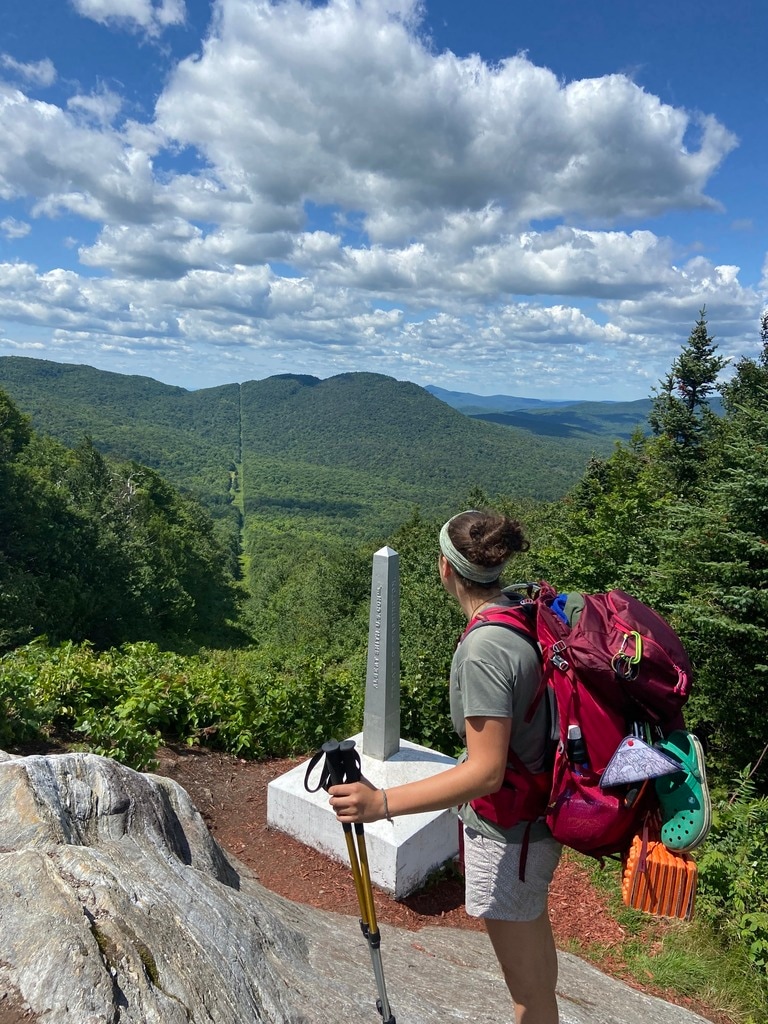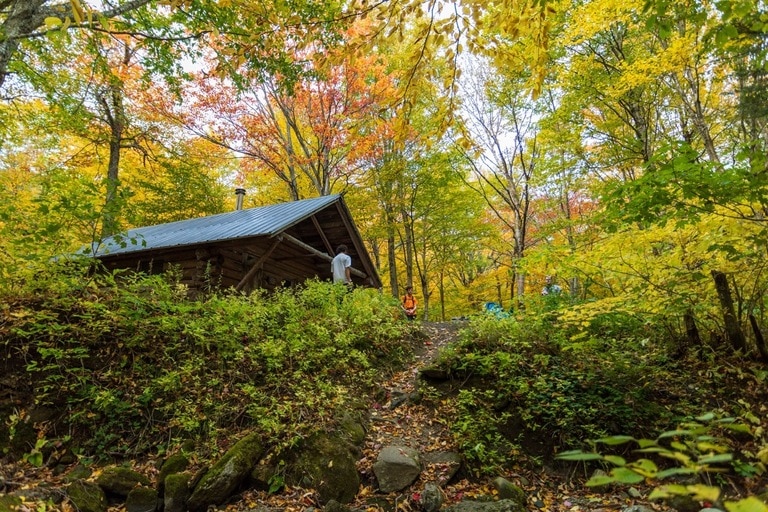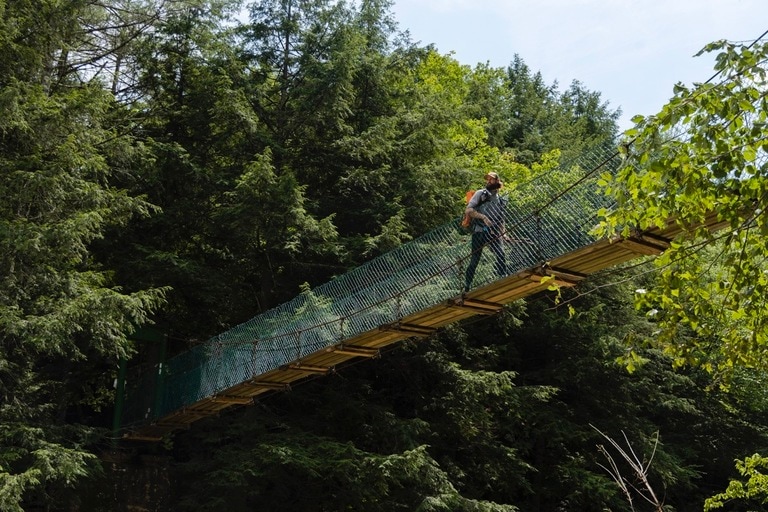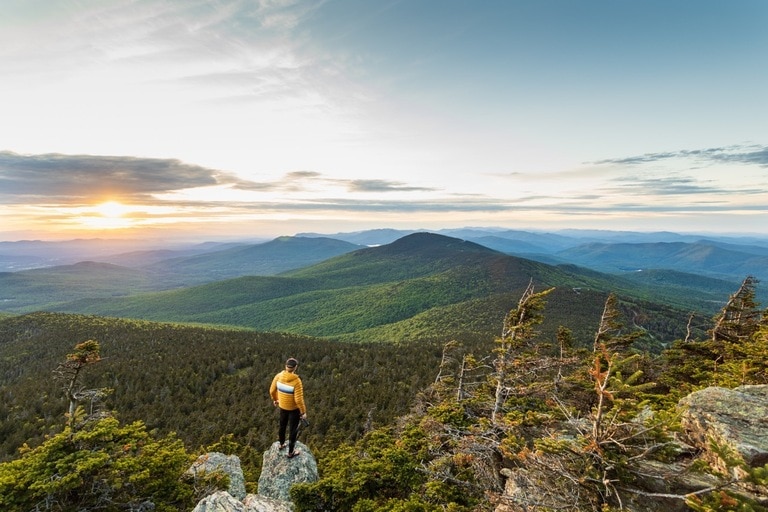The 272-mile Long Trail winds through Vermont's lush Green Mountains, leading backpackers over the state’s highest peaks, through dense forests and past scenic waterways. It’s the United States’ oldest established long-distance trail. The Green Mountain Club (GMC) founded in 1910 and began designing the trail with the ambitious goal of spanning the state’s entire length, and work was completed in 1930. The Long Trail inspired the Appalachian Trail (AT), with which it shares about 105 miles in southern Vermont.
The trail begins at the Massachusetts-Vermont border and extends north to the Canadian border. Despite its name, the trail is relatively short compared with the AT (2,197 miles) and Pacific Crest Trail (2,653 miles), but it’s also anything but easy. The route features rugged terrain with steep and muddy sections that challenge even seasoned hikers.
“It’s a lot harder than you would expect,” says Emily Mosher, GMC’s visitor services manager. “It was built at a time when trail design just went straight up the mountain and straight back down, not with the switchbacks that we think of on the West Coast.” Since record-keeping began in 1942, about 8,000 hikers have completed the entire trail, either in one continuous trek or over several years, and have GMC’s certificate to prove it.
The mountain club continues to maintain the trail. It collaborates with partners like the U.S. Forest Service, Green Mountain National Forest, the state of Vermont and the Appalachian Trail Conservancy to keep the trail and its 70 backcountry campsites—many of which have shelters and privies—in good condition.
There's a lot to consider when planning to hike the Long Trail. In this guide, we'll cover everything you need to know to get ready for the trek.
- Why hike the Long Trail?
- Traveling northbound vs. southbound
- Stopping along the Long Trail
- Planning your trip
- What to pack
Why hike the Long Trail?
Many thru-hikers consider the Appalachian, Continental Divide or Pacific Crest trails to be the pinnacle of achievement, but the Long Trail is worth considering as a challenge too. Though comparably short, it's both formidable and gratifying. "Hikers often share how challenging the trail is, how much of a mental game it becomes, but also how accomplished they feel when they finish," Mosher says. "For me, there was nothing like seeing that northern terminus sign." She also notes that the Long Trail is ideal for peak baggers, as it crosses four of Vermont's five 4,000-foot summits—Mount Mansfield (4,395′), Camel’s Hump (4,083′), Mount Ellen (4,083′) and Mount Abraham (4,006′)—and passes near the fifth, Killington Peak (4,235′), accessible via a 0.2-mile trail spur.
The Long Trail is also a great way to gauge your readiness for longer trails. The trail was the first backpacking experience for Kyle O’Grady, the Vermont-raised hiking and backing YouTuber, before he took on the Appalachian Trail and most of the Pacific Crest Trail. O’Grady believes that “if you can thru-hike the Long Trail, you can thru-hike any of the other long-distance trails.”
Kelly Pope chose the Long Trail because it fit the time she had available. “I wanted to do a thru-hike, but I only had about a month,” says the Washington resident, seasoned backpacker and former REI contractor on the partnerships and brand strategy team. According to the Green Mountain Club, the average time to complete the Long Trail is 20 to 35 days.
Hiking the Long Trail is also a fantastic way to experience Vermont, as it takes you through many of the state’s picturesque villages. Depending on your budget, you can enjoy "zero" days (that is, days off from hiking) in these towns, dining at restaurants, sampling the local cheeses and beers, resupplying at general stores, and resting at Vermont’s characteristic bed and breakfasts. "It's worth flying in to do," O’Grady says of the trail. "You will absolutely have an amazing trip coming to Vermont.” (See Stopping Along the Long Trail, below, for more information.)
Another perk of hiking the Long Trail is that no permit is required for individual hikers, making it easier to plan your adventure on your own terms. You can hit the trail without worrying about reservations or extra fees, allowing for a more spontaneous, flexible, or laid-back trip. (Hikers moving in groups may need a permit from the National Forest Service or the state parks department.)

Photo credit: Emma Sekercan
Traveling northbound vs. southbound
You can hike the Long Trail in either direction: northbound (NOBO) or southbound (SOBO). Each direction has its own unique set of benefits and drawbacks.
Southbound (SOBO): Beginning at the Canadian border, the southbound (SOBO) route is ideal if you're starting in the fall and want to avoid colder weather at higher elevations. The trail’s northern section is the more demanding, with precipitous climbs and tricky terrain. “A lot of the northern section is hand-over-hand climbing up walls of slippery roots and rocks,” Pope says. “On Day Two, I slipped on a boulder and got a black eye, and on Day Three I celebrated when I could take 10 steps in a row on level ground for the first time.” Starting here makes the trail progressively easier as you head south. However, this direction demands more preparation and fitness since you begin with the hardest part.
Northbound (NOBO): Starting at the Massachusetts border, the northbound (NOBO) route is the more popular choice for Long Trail hikers. The southern section offers moderate terrain, allowing you to build up stamina before tackling the rough northern peaks. “You'll get your trail legs under you, and get the experience where there are more resources around in terms of people and amenities, before you head to the more remote sections of Vermont,” says Mosher. The trail ends at the Canadian border, providing a satisfying finish at the tell-tale obelisk that marks the northern terminus.
Stopping along the Long Trail
While the Long Trail offers remote wilderness, the charming towns scattered alongside it are perfect for resupplying, resting and exploring. Here are some top stops to consider:
- Bennington: This college town is often bypassed by NOBO hikers since it’s located so close to the southern terminus, but it has southern Vermonth’s highest population (and greatest number of amenities).
- Manchester: Largely known by non-hikers for its upscale hotels and outlet shopping, Manchester is a favorite town on both the AT and Long Trail for its many amenities, including dining and lodging options for hikers. The downtown area is eminently walkable, making it a convenient place to resupply and take a rest day.
- Rutland: A classic stop for both LT and AT hikers, Rutland is one of the larger towns you'll visit, with grocery stores, restaurants, hostels and medical facilities. An inn is conveniently located right where the trail crosses a road.
- Waitsfield/Warren: These twin towns in the Mad River Valley offer a taste of rural Vermont. They are solid options to relax and recharge, and they offer grocery stores, restaurants, craft breweries and family owned inns and hostels—many of which offer trailhead pick-ups for hikers.
- Waterbury: After descending Camel’s Hump, one of Vermont’s highest and most beloved peaks, NOBO hikers enter Waterbury, another excellent resupply stop. The town offers easy access to essentials. It’s also home to the Green Mountain Club headquarters, where you can get trail updates, maps and expert advice.
- Stowe: Hikers heading NOBO encounter Stowe after tackling Vermont's highest point, Mount Mansfield. Known for its ski resorts and characteristic charm, Stowe offers a range of accommodations, from rustic lodges to luxury hotels, as well as restaurants and shops, making it a perfect place to rest before taking on the final stretch.
- Johnson: Located along the Lamoille River, Johnson is one of the last resupply towns before heading into the trail’s remote northern reaches. Even if you're not staying overnight, it’s worth a stop: You can stock up on supplies before knocking out your trek’s final miles.

Photo credit: Matt Heller
Planning your trip
Best Time to Hike the Long Trail
While a few brave souls tackle the LT in winter, summer and fall are the prime seasons to go. The Green Mountain Club advises against hiking during "mud season," which runs from late March or early April through May. During this time, snowmelt and spring rains can cause damage and erosion along the trail.
With that in mind, here’s a breakdown of what to expect during different months of the traditional hiking season:
Late May and June: By mid-June (though often earlier), the snow is generally gone from the trail and the temperatures are pleasantly warm. This is the start of black fly season, however. The trail can also be quite muddy (Vermont's nickname among hikers is "Vermud"). Expect some slippery conditions.
July and August: Summer months bring warm temperatures and long daylight hours, making them the most popular times for hiking. Be ready for crowded sections, especially near major mountain peaks, and occasional heat waves that cause temperatures to soar above 80°F. The bright side of warmer temperatures? You’ll skip the chillier fall nights and get the chance to enjoy swimming in the ponds and rivers along the trail. Take a dip in Clarendon Gorge’s clear waters, relax by the Big Branch River, or enjoy the peaceful settings at Little Rock Pond and Stratton Pond. All are perfect spots for a refreshing break on a hot day.
September: With cooler temperatures, fewer bugs and reduced competition for shelter space, early fall is arguably the best time to hike the Long Trail. Be prepared, however, for temperatures to drop below freezing at night.
October: Hiking in October means facing the possibility of early snow. "After early October, you could be fine, but you're just rolling the dice. It's going to be really cold, and you might get a little bit of a dusting of snow in various spots," says O’Grady. It’s essential to be prepared for icy conditions and cold temperatures if you choose to hike at this time.

How to get to the Long Trail
Getting to the Long Trail can be a logistical puzzle, particularly for those flying into the region. The Pine Cobble Trail, which serves as the approach trail to the southern end of the Long Trail, starts in the quaint town of Williamstown, Massachusetts—roughly a 60- to 90-minute drive from Albany International Airport. The trail's northern terminus, accessible via Journey’s End Trail, is even more remote: more than 90 minutes by car from Burlington Airport. Your best bet may be to arrange a private shuttle or ride to drop you off at the start of your hike and pick you up when you finish.
Check the Green Mountain Club website for resources, trail information and planning tips. You can also email the Visitor Center at gmc@greenmountainclub.org for a list of private shuttle drivers. Pope, the Washington hiker, did this. A volunteer picked her up at Burlington Airport; took her to an REI for last-minute supplies; drove her to the northern terminus; and even brought breakfast.
How to prepare for hiking the Long Trail
The Long Trail is not for the faint of heart. "It has a unique toughness," O’Grady says, noting its harsh terrain and the frequent rainy weather that hikers often endure. “Every trail has its challenges, but people from outside New England or the Northeast might not realize just how tough a trail in Vermont can be.” The northern section is especially arduous.
To prepare, you’ll want to be in excellent physical shape—regular cardio workouts, strength training, and weighted pack hikes are excellent prep.
Whether you’re a first-time thru-hiker, experienced backpacker or brand new to the outdoors, our Expert Advice library has a wealth of information to help you prepare for your specific trek.
Read the following articles to learn more and plan effectively:
- How to Train for Thru-Hiking
- How to Train for Backpacking
- Weather Basics for Backpackers
- How to Plan a Backpacking Trip
- How to Go Backpacking in the Rain
It’s also crucial to "hike your own hike.” Yes, you should create a rough itinerary before you hit the trail. But stay flexible. New England’s weather can be unpredictable. And, for various reasons, you won’t always hit your daily mileage goals. Adjustments are part of the adventure, so try to embrace them. Equally important, know when it’s time to turn back.
You’ll also want to be sure to read up on wildlife safety, as black bear sightings have increased along the Long Trail in recent years:
Depending on when you go, be mindful about hunting season. Hunting is permitted along the trail. During hunting season (September through December) you should only hike during daytime hours (avoiding dusk and dawn), wear blaze orange for visibility, and pay attention to posted notices on- and near the trail.
Finally, before you set out, be sure to check the GMC website for any reroutes, shelter closures or other changes. (Flooding has been a particular issue on the trail in recent years.)

Photo credit: Matt Heller
What to pack for the Long Trail
For any journey, you should always pack the Ten Essentials. The rest of your kit may vary depending on the season you’re hiking, your preferences and your budget. Here are some recommendations from past Long Trail hikers Mosher, O’Grady and Pope.
Footwear: Sturdy hiking boots or trail runners are essential. Make sure to break them in before hitting the trail. Mosher suggests footwear with good traction and support, as the trail is rocky and rooty. It’s also important to pick shoes that repel water and/or dry quickly since your feet are sure to get wet. (Learn more about how to choose, lace and break in hiking boots with our article collection Hiking Boot Basics.)
Hiking socks: Invest in high-quality wool, polyester or nylon socks to keep your feet dry and prevent blisters. Bring at least two pairs so you can rotate them daily, because, like your shoes, they’re bound to get wet. (Read more in How to Choose Hiking Socks.)
Multiday backpack: Ultralight backpackers can get away with a 44-liter pack, but most will probably want a 60- or 65-liter pack. This will also vary by the season: Cold or rainy weather will require additional layers (think: heavier base layers, gloves, long underwear). (Learn more about How to Choose a Backpack and How to Size and Fit a Backpack.)
Backpacking tent or ultralight hammock: Even though the Long Trail has more than 70 shelters, spaced about 8 to 10 miles apart, Mosher recommends bringing a tent or hammock just in case the lodging is full or you need to stop early. Choose a tent that’s easy to set up and well-ventilated to avoid condensation in the humid Green Mountains. (Related reading: How to Choose a Backpacking Tent) Alternatively, consider packing a hammock, as there are plenty of trees for hanging one along the trail. (Read How to Hammock Camp for more information about overnighting above ground.)
Sleeping system: Unless you’re sleeping in a hammock, a comfortable sleeping pad and a warm sleeping bag are key to recovering from the strain that long-distance hiking places on your body. Choose a sleeping bag rated for the lowest temperatures you can expect on your outing, and a sleeping pad that offers good insulation. You may also consider packing a backpacking pillow for extra comfort, if you can spare the pack space. (Related reading: Understanding Sleeping Bag Temperature Ratings, How to Choose Sleeping Bags for Backpacking, How to Choose Sleeping Pads)
Base layers: Pack a moisture-wicking base layer to help regulate your body temperature, keep you warm (particularly at night) and stay dry. (Read How to Choose Base Layers to learn what fabrics and weight will work best for your trip.)
Down jacket: A lightweight down jacket is an essential layer not only for staying warm, but also because its compressibility makes it easy to pack.
Rain gear: Staying warm and dry is crucial on the Long Trail, where rainy conditions are practically guaranteed. A good rain jacket is a must, but McGrady says it's also essential to protect your sleeping bag and extra clothes from getting wet. Even with a waterproof backpack, it's smart to use a rain cover and line your pack with a trash compactor bag or neoprene to keep everything dry.
Bear-proof food storage: Vermont is home to black bears. While they generally avoid humans, they can become accustomed to finding food at campsites, increasing your chances of a run-in. The GMC advises using proper food storage to stay safe and protect wildlife. Many shelters along the Long Trail have bear boxes for hikers to use, but it's also critical to bring along bear-proof storage like a bear bag or bear canister and that you know how to use it. (Learn more about peacefully coexisting with bears with Food Storage and Handling for Campers and Backpackers and Backpacking in Bear Country.)
Water filtration system: Access to clean drinking water is crucial while hiking. Fortunately, springs, creeks and rivers are plentiful on the route; check with the Green Mountain Club (GMC) for trail updates, as some sources may dry up during droughts. While boiling or chemical treatment are options, most hikers rely on filtration systems. Choose a reliable water filtration system—whether a pump filter, gravity filter or chemical treatment—based on your water needs and space in your pack. (Read How to Choose a Water Filter or Purifier to help narrow it down.)
Headlamp: A lightweight, waterproof headlamp is key for navigating in the dark and for nighttime tasks around your campsite. Be sure to bring extra batteries or a rechargeable power bank. (Read How to Choose Headlamps to determine what features are right for your hike.)
Cooking gear and food: A hot meal can really boost your spirits after hiking on a cold or rainy day. But to prepare it on the trail, you'll need a lightweight stove, fuel, a pot and a lighter. Some ultralighters opt to cold soak their food instead, which requires some planning and plenty of water. No matter how you like to eat on the go, be sure to plan your meals so you have enough to last until your next resupply. (Related reading: Backing Food Ideas & Meal Planning.)
Trekking poles: Trekking poles can ease the strain on your knees and provide stability on the Long Trail’s occasionally clifflike terrain. “I don't think I could have completed the trail without them,” says Pope, who used poles for the first time on this hike. “They saved my knees so many times. On the steep inclines and descents they were a necessity.” (Learn How to Choose Trekking Poles and Hiking Staffs—and then How to Use Trekking Poles and Hiking Staffs.)
Insect repellent: You'll want to carry insect repellent to protect yourself from mosquitoes, ticks and other pests, year-round. Black fly season (May through June) is especially notorious on the Long Trail, but they don’t respond much to insect repellent, so also consider bringing a head net. (Related reading: How to Choose Insect Repellent.)
Satellite messenger: Cell service is generally good on the higher elevations of the Long Trail but can be spotty at road crossings, so consider using a satellite messenger device for extra wilderness safety or for reaching whoever is picking you up at resupply points. (Related reading: How to Choose Between a PLB and a Satellite Messenger.)
Travel journal: Want to officially register your hike with the Green Mountain Club and earn a certificate? Each night before bed, record the date, where you camped and what you did that day. Not only will it help you complete your end-to-end application, but it will also preserve the memories of all the difficulties and triumphs of your Long Trail adventure.


